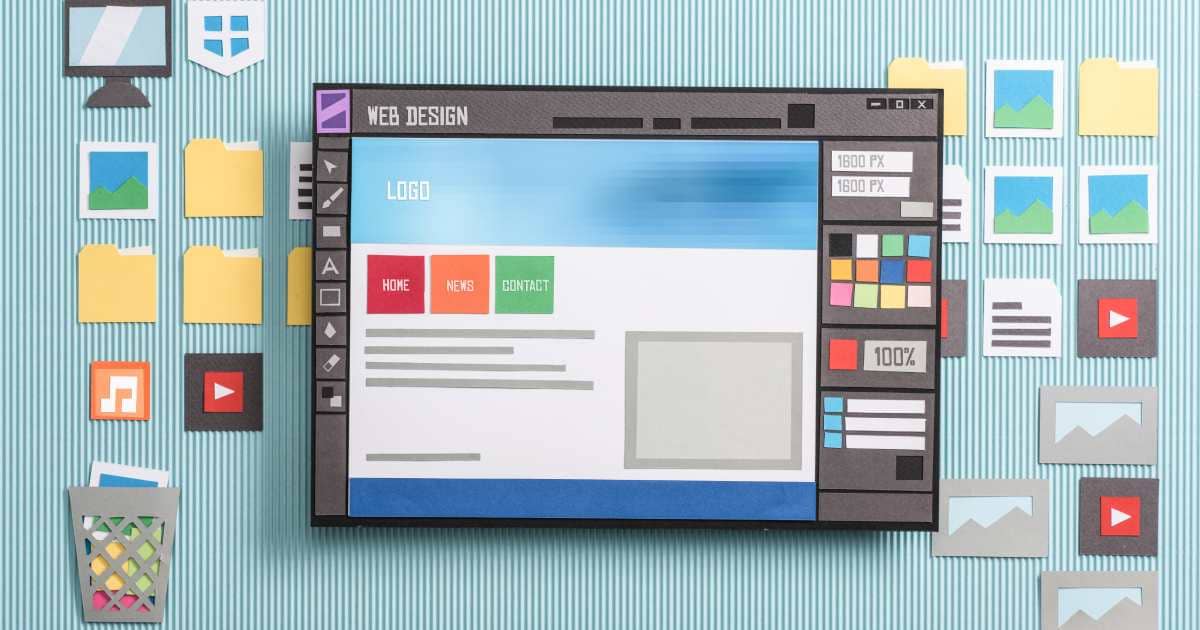Website design plays a crucial role in the success of any online business. When it comes to search engine optimisation (SEO), the design of a website becomes even more important. A well-designed website not only enhances the user experience but also improves search engine rankings. A user-friendly website aims to improve the overall user experience and increases the chances of visitors staying longer on the website, interacting with the content, and converting into customers. In this article, we will explore the most important elements of website design for SEO, including navigation, call to action, website speed, typography, branding, colours, and more. By implementing these elements effectively, website owners can ensure that their site is optimised for search engines and user-friendly.
Navigation
Navigation is a fundamental aspect of website design that directly impacts both SEO and user experience. A well-structured and intuitive navigation system allows users to easily find the information they are looking for, which leads to longer session durations and lower bounce rates. From an SEO standpoint, search engines rely on effective navigation to crawl and index a website’s pages. This means that a poorly designed navigation structure can hinder search engine bots from properly exploring and indexing your site, resulting in poor visibility in search results.
To optimise website navigation for SEO, it is essential to incorporate a clear and logical hierarchical structure. This involves organising your website’s pages into categories and subcategories, making it easy to navigate for both users and search engines through the content. Additionally, implementing breadcrumbs and a sitemap can further enhance the navigation experience and improve SEO. By providing users with a clear path to navigate your website and allowing search engines to understand the structure of your site easily, you can significantly improve your SEO performance.
Website Accessibility
Website Accessibility is a crucial aspect of website design that should never be overlooked. Inclusive design not only benefits users with disabilities but also improves the overall user experience and SEO. When designing a website, it is essential to consider users with visual impairments, hearing impairments, motor disabilities, and cognitive disabilities. By incorporating accessibility features, such as alt text for images, transcripts for videos, and keyboard navigation, you can ensure that your website is accessible to all users.
From an SEO perspective, accessible websites tend to perform better in search engine rankings. Search engines value websites that provide equal access to information for all users. By implementing website accessibility features, you are sending a positive signal to search engines that your website is user-friendly and inclusive. This can result in higher rankings and increased organic traffic. Moreover, accessible websites also tend to have better user engagement metrics, such as lower bounce rates and longer session durations, which further contribute to improved SEO performance.
Website Speed
Website speed is a critical factor that affects both user experience and SEO. In today’s fast-paced digital world, users expect websites to load quickly. If a website takes too long to load, users are likely to abandon it and look for alternatives. This not only leads to a poor user experience but can also be a negative ranking factor.
To optimise website speed, it is crucial to minimise the size of your web pages and optimise the loading of assets, such as images, CSS, and JavaScript files. Compressing images, minifying code, and leveraging browser caching are effective techniques to reduce page load times. Additionally, choosing a reliable hosting provider and using a content delivery network (CDN) can further improve website speed.
From an SEO perspective, websites that load quickly tend to have lower bounce rates and higher user engagement metrics, such as longer session durations and higher conversion rates. By optimising your website for speed, you can improve user experience, increase organic traffic, and enhance your SEO performance.
Call to Action
A call to action (CTA) element in website design encourages users to take a specific action, such as making a purchase, signing up for a newsletter, or contacting the business. From an SEO perspective, a well-designed call to action can significantly impact conversion rates and user engagement metrics, both of which are vital for SEO performance.
When designing a call to action, it is essential to make it visually appealing and prominently placed on the page. The text of the CTA should be concise, action-oriented, and clearly convey the benefit or value proposition to the user. Additionally, using contrasting colours for the CTA button can make it stand out and attract the user’s attention. By optimising your call to action for conversions, you can improve user engagement and ultimately boost your website’s SEO performance.
Typography
Typography is an important aspect of website design, both from a visual perspective and an SEO standpoint. The right typography can enhance the visual appeal of a website and improve readability, which in turn contributes to a better user experience. From an SEO perspective, using appropriate typography can improve the accessibility of your website, enhance keyword visibility, and contribute to better search engine rankings.
When choosing typography for your website, it is essential to consider factors such as font size, font style, and line spacing. A font size that is too small can make it difficult for users to read your content, while a font size that is too large can disrupt the visual hierarchy of your website. Similarly, using a font style that is easy to read and matches the tone of your website can significantly improve readability.
From an SEO perspective, using appropriate heading tags (H1, H2, H3, etc.) can improve keyword visibility and help search engines understand the structure of your content. Additionally, using descriptive anchor text for links can provide search engines with valuable context and improve the relevance of your website for specific keywords. By paying attention to typography, you can enhance the visual appeal of your website, improve readability, and optimise your website for better SEO performance.
Branding
Branding is a crucial aspect of any business, and it should be seamlessly integrated into website design. From a visual perspective, consistent branding elements, such as a logo, colour scheme, and typography, create a cohesive and professional look for your website. From an SEO standpoint, integrating branding into website design can contribute to better search engine rankings and improved user engagement. When designing your website, it is essential to incorporate your brand’s visual elements consistently across all pages. This creates a sense of familiarity and helps users recognise and connect with your brand. Additionally, using branded keywords in your website’s content and meta tags can further reinforce your brand’s visibility in search results. From an SEO perspective, branding can also impact user engagement metrics. A strong brand identity can create trust and credibility, which leads to
Colours
Colour is a powerful tool in website design that can evoke emotions, create visual interest, and enhance user experience. When it comes to SEO-friendly website design, choosing the right colours is crucial for both visual appeal and search engine optimisation. When selecting colours for your website, it is essential to consider your brand identity, target audience, and the emotions you want to evoke. Different colours have different psychological effects, and they can influence how users perceive your website and interact with it.
For example, warm colours like red and orange can create a sense of urgency, while cool colours like blue and green can create a calm and soothing atmosphere. From an SEO perspective, using appropriate colours can improve the readability of your website and enhance keyword visibility. For example, using a high-contrast colour scheme between the background and text can make your content easier to read, especially for users with visual impairments. Additionally, using colours strategically in your call-to-action buttons can attract the user’s attention and encourage conversions. By carefully selecting colours for your website design, you can create a visually appealing and SEO-friendly website.
Hamburger Menus
Hamburger menus have become a popular design trend in recent years, especially for mobile websites. This type of menu consists of three horizontal lines stacked on top of each other, resembling a hamburger. While hamburger menus can save screen space and create a minimalist design, they also have their pros and cons in terms of SEO. One of the main advantages of using hamburger menus is that they allow for a clean and uncluttered design. On mobile devices, where screen space is limited, hamburger menus can help prioritise content and provide a seamless user experience. Additionally, hamburger menus are easy to implement and can be customised to match the overall design of your website.
However, from an SEO standpoint, hamburger menus can present some challenges. One of the main drawbacks is that they can hide important navigation options from users. Since the menu is hidden behind an icon, users may not realise that there are additional pages or sections available. This can lead to lower engagement, as users might miss valuable content on your website. From a search engine perspective, hamburger menus can also pose challenges. Search engine bots rely on clear and accessible navigation to crawl and index websites. If important navigation options are hidden behind a hamburger menu, search engine bots may not be able to discover and index all the pages on your website, resulting in lower visibility in search results.
Overall, the decision to use a hamburger menu should be based on careful consideration of your website’s goals, target audience, and content. If screen space is a concern, and your website has a simple and straightforward structure, a hamburger menu can be an effective design choice. However, if your website has a complex navigation structure or relies heavily on specific pages or sections, it may be more beneficial to use a traditional menu that is visible at all times.
Images
Images are essential to website design, as they can enhance the visual appeal and engage users. However, from an SEO perspective, it is crucial to optimise images to ensure they contribute positively to your website’s performance in search engine rankings. One of the main aspects of image optimisation is file size. Large image files can slow down your website’s loading speed, which can negatively impact user experience and SEO. To optimise image file size, you can use compression techniques, such as reducing image dimensions or using image compression tools. This ensures that your images load quickly without compromising their visual quality.
Additionally, it is important to use descriptive file names and alt text for your images. Search engines rely on this information to understand the content of your images and index them appropriately. By using relevant keywords in your image file names and alt text, you can improve the visibility of your images in search results.
Furthermore, properly formatting and resising images for different devices, such as desktops, tablets, and mobile devices, can enhance user experience and SEO. This ensures that your images are displayed correctly and load quickly across various devices, contributing to a better overall performance. By optimising your images for SEO, you can improve your website’s visibility in search results, enhance user experience, and ultimately drive more organic traffic to your site.
Readability
Readability is also a crucial factor in creating an appealing layout. To ensure readability, it is important to choose fonts that are legible on different devices and screen sizes. Additionally, using appropriate font sizes and line spacing can greatly enhance the readability of the content. Using bullet points, subheadings, and short paragraphs can also enhance readability, making it easier for users to scan through the content and find the information they need. Breaking down the content into bite-sized chunks makes it easier for users to scan the information and find the key points. This not only improves readability but also increases the chances of users engaging with the content and sharing it with others.
User Interaction
User interaction is a critical factor that search engines consider when determining the quality and relevance of a website. It is essential to design your website in a way that encourages user interaction. One of the key ways to enhance user interaction is by providing valuable and engaging content. By creating high-quality, informative, and relevant content, you can attract and retain users on your website. This can be achieved through blog posts, articles, videos, infographics, and other forms of content that resonate with your target audience.
Another way to enhance user interaction is by incorporating interactive elements into your website design. This can include features such as quizzes, surveys, polls, interactive maps, and calculators. These interactive elements not only keep users engaged but also provide valuable data that can be used to improve your website and marketing strategies. Furthermore, integrating social media sharing buttons and allowing users to leave comments and reviews can also enhance user interaction. This encourages users to share your content with their networks and provides social proof, which can improve your website’s credibility and visibility in search results.
By focusing on enhancing user interaction, you can improve user engagement metrics and ultimately boost your website’s SEO rankings.
Layout
When it comes to website design for SEO, the layout of a website is of utmost importance. A well-structured layout not only enhances the user experience but also helps search engines understand the content of a website. One crucial aspect of layout consideration is the navigation menu. A clear and intuitive navigation menu allows users to easily find what they are looking for, while also providing search engines with a clear hierarchy of the website’s pages.
Another important layout consideration is the placement of key elements such as the call to action (CTA). A strategically placed CTA can significantly improve the conversion rate of a website. It is essential to ensure that the CTA is easily visible and stands out from the rest of the content.
White Space
White space, also known as negative space, refers to the empty space between elements on a webpage. While it may seem counterintuitive, utilising white space effectively can greatly improve the SEO-friendliness of a website. White space helps create a visually appealing layout by providing breathing room between elements, making it easier for users to focus on the content. It also improves readability by reducing clutter and enhancing the legibility of text.
From an SEO perspective, white space plays a crucial role in enhancing user experience, which in turn improves the website’s metrics such as bounce rate and time on page. Search engines consider these metrics as indicators of a website’s relevance and quality, thus influencing its ranking in search results. Therefore, incorporating white space strategically throughout the website design can have a positive impact on both user experience and SEO.
Responsive Design
Responsive design is crucial for SEO. With the increasing use of mobile devices, having a website that adapts to different screen sizes and resolutions is essential for providing a seamless user experience. A responsive website ensures that users can easily navigate through the content and access the information they need, regardless of the device they are using.
From an SEO perspective, responsive design is also important because it helps improve the website’s mobile friendliness, a factor that search engines consider when ranking websites for mobile search results. A mobile-friendly website not only improves the user experience but also increases the chances of attracting organic traffic from mobile users.
User Experience is Key to Successful Website Design
Website design is much more than just making a visually appealing website. The most important elements of website design are the ones that focus on providing a great user experience. Factors such as ease of navigation, relevant content, strong call-to-actions and fast loading times not only enhance the user experience but also help boost the website’s search engine rankings.
Keeping these key elements in mind while designing a website ensures that your website delivers a seamless user experience and drives positive results. Remember, a well-designed website is not only aesthetically pleasing, but it also serves as a powerful marketing tool that can greatly benefit your business. So, it is essential to incorporate these vital elements into your website design to make it successful. When all elements are in harmony, it can lead to a positive online impact and drive better results for any business.




